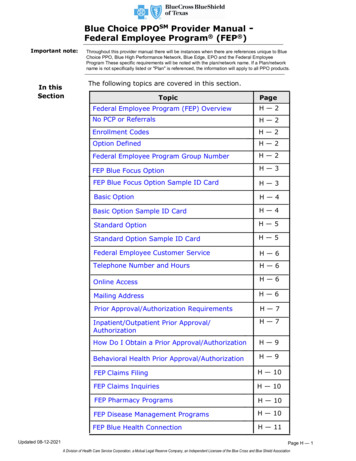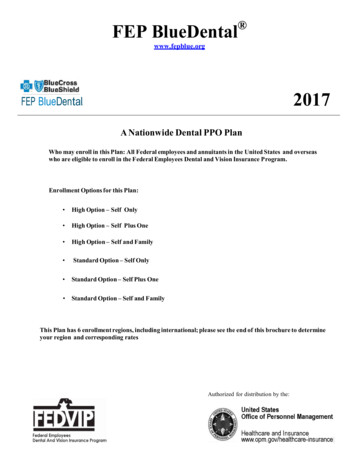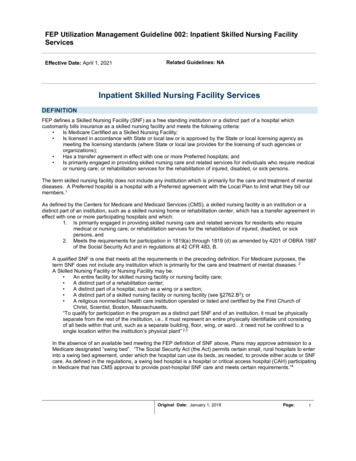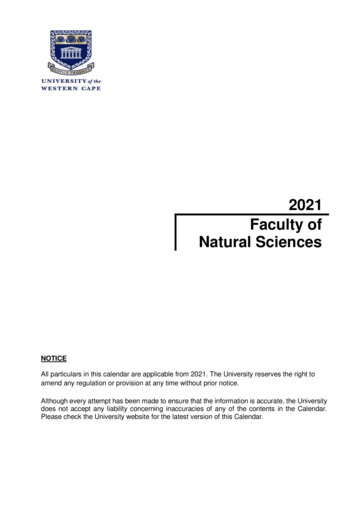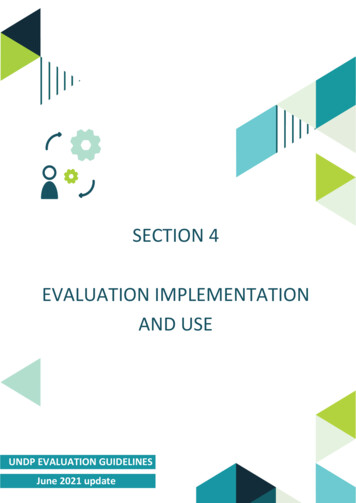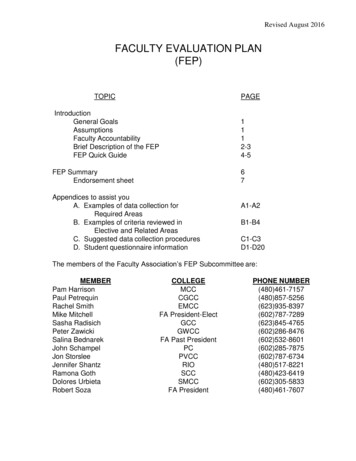
Transcription
Revised August 2016FACULTY EVALUATION PLAN(FEP)TOPICPAGEIntroductionGeneral GoalsAssumptionsFaculty AccountabilityBrief Description of the FEPFEP Quick Guide1112-34-5FEP SummaryEndorsement sheet67Appendices to assist youA. Examples of data collection forRequired AreasB. Examples of criteria reviewed inElective and Related AreasC. Suggested data collection proceduresD. Student questionnaire informationA1-A2B1-B4C1-C3D1-D20The members of the Faculty Association’s FEP Subcommittee are:MEMBERPam HarrisonPaul PetrequinRachel SmithMike MitchellSasha RadisichPeter ZawickiSalina BednarekJohn SchampelJon StorsleeJennifer ShantzRamona GothDolores UrbietaRobert SozaCOLLEGEMCCCGCCEMCCFA President-ElectGCCGWCCFA Past PresidentPCPVCCRIOSCCSMCCFA PresidentPHONE 602)305-5833(480)461-7607
FACULTY EVALUATION PLANIntroductionGENERAL GOALSAs a result of changes in faculty instructional roles, responsibilities and delivery systems, a District FacultyAssociation Evaluation Committee was formed to examine the evaluation process used by the Maricopa Collegefaculty since 1986. As they designed a Faculty Evaluation Plan (FEP), the committee adopted assumptions thatwere distributed to faculty. They also conducted two surveys, as well as possible data, who collects it, and the formin which the data is presented from which a new evaluation plan was created. In 2005-2006, the Faculty EvaluationPlan was updated in the Meet and Confer process (RFP 3.5.). The FEP Subcommittee developed the updatedRequired, Elected, and Related areas to be assessed.The committee's goal regarding the FEP is to move away from "traditional" means of faculty evaluation. Instead,they have concentrated on a process to assist faculty in their common mission to meet student needs. The committeerecognized that most faculty continually seek to improve their effectiveness and this proposed system should supportthat effort. The FEP is also aligned with the MCCCD vision and mission.ASSUMPTIONSFaculty Commitment to Improvement As faculty members, we are committed to improving our instructional and service effectiveness. Faculty acknowledge our accountability for our professional performance. While most faculty members are committed to continuous improvement through their own effort,they perceive that performance is also enhanced through support and guida nce from colleagues(Maricopa Community Colleges Faculty Evaluation Survey, Fall 1994).Goals of the Faculty Evaluation Plan The FEP concentrates on assessment for improved performance. The research evidence that existsindicates that traditional evaluation methods do not consistently lead to improved instruction.(Centra,1993, p. 11) The FEP is an evaluation system that expands beyond that traditional model. The new FEP identifies and acknowledges not only effective teaching but also other facultyservice beyond the classroom.Administrative review of faculty for retention/dismissal(per Residential Faculty Policy 6.6.) remains separate from the FEP. FACULTY ACCOUNTABILITYEach faculty member doing an FEP remains accountable to the department/ division chair and the college VicePresident Academic Affairs for satisfactory completion of the FEP. Faculty members may implement their Planoption as often as they wish, but must complete a Plan every third year when appointive, as currently required bythe RFP. The faculty member to be evaluated and members of the evaluation team who assist with an FEP sign an"endorsement sheet" verifying that the process has been completed.1
Brief Description of the FEPThe main goal of this proposed plan is to refocus the current RFP mandated faculty evaluation system toward emphasizing therecognition and encouragement of improved performance and not just gathering evaluation data for personnel decisions.While keeping some parts of the previous, more traditional method of faculty evaluation, the proposed FEP plan recognizes anexpanded image of the role of Maricopa faculty that goes beyond classroom instruction, for example, faculty serving in non-teachingroles (librarians, counselors, program managers, etc.) and other professional faculty involvement such as advising and mentor ingstudents, participating on college/district committees, departmental interaction with colleagues, etc.It has been designed to avoid the traditional “cookie cutter” approach to faculty evaluation requiring the same procedure for all. Thegoal of the proposed FEP is to allow more flexibility to reflect more accurately the diverse faculty roles and the uniqueness ofdifferent teaching styles and teaching in different disciplines. This includes the opportunity to customize the FEP, allowing a facultymember to obtain more useful and applicable information while assessing their performance as they strive to improve instruction orthe effectiveness of other professional services.In searching the literature on faculty evaluation, the Faculty Evaluation Committee which developed the FEP has come to suppo rtstrongly this observation: “Improved performance only occurs when faculty: (1) learn something new about their performance,(2) value the information and have confidence in its source, (3) know how to make changes based on it, (4) are motivated to m ake thechanges” (Centra, 1993, p. 9). The team of individuals that assist a faculty member in developing and implementing an FEP should beguided by these values.Key Elements of the FEP1.Recognizing the movement toward broadening the definition of instruction-time beyond the traditional semester, theproposed FEP can begin at any time within the fiscal year but must be completed by June 30 th of the same fiscal year. Thecollege Vice President Academic Affairs, through the appropriate department/division chair, will be responsible for notifyinga faculty member to begin the FEP.2.It is recommended that each college Faculty Senate appoint a “RESOURCE PERSON” who is familiar with the FEP tohelp facilitate the process. The college Faculty/Staff Development Specialist is a suggested candidate for this position.(According to Centra [1993, p. 11] “A trained faculty development instructional specialist has the potential to help instruct orssignificantly change their teaching and should be involved in the process.”)3.Faculty must complete (or review and update) a plan every third year (or more often if desired) when “appointive.” Thisprocess should also include part-time faculty--although the FEP would be modified by/for these faculty members in order toaccommodate differences in their roles. (The existing process to evaluate adjunct faculty will remain in place)4.To complete an FEP each faculty member must engage in a self-examination of “THREE REQUIRED AREAS”: TEACHING (OR OTHER PRIMARY DUTIES). For example, instructional or service delivery, contentexpertise, classroom or program management, instruction/program design. COURSE OR PROGRAM DEVELOPMENT/REVISION. For example, a review of syllabi, tests, and courseorprogram content, including competencies and objectives. GOVERNANCE AND/OR COMMITTEE PARTICIPATION AT THE COLLEGE AND/OR DISTRICTLEVELSIn addition to an assessment of these “3 REQUIRED AREAS” (RFP Section 3.5.3.1.) , “AT LEAST TWO ELECTED AREAS”(RFP Section 3.5.3.2.), and other “RELATED AREAS” (REP Section 3.5.3.3.) may also be selected by the faculty member toreview, in order to bring into better focus their full professional involvements at the college or within the District. Examples includeprogram coordination, research projects, department/division chair responsibilities, student activities -advising/mentoring, professionalinvolvement in the community, professional growth, involvement/projects, professional interaction with colleagues, etc.See (Appendix B) for details.2
5.As a means of designing an FEP that is flexible enough to respect the broad diversity of the faculty role, a faculty memberdeveloping and implementing the plan should select ways of examining his/her performance that will most effectivelydescribe his/her: current performance, future goals and actions needed to achieve them, accomplishments in the professionalareas to be examined, etc. These may include different means of assessment for each of the “REQUIRED,”“ELECTIVE,” and “RELATED” areas that are evaluated. Examples of different means include checklists, observations,student evaluation instruments (which can be customized), student skill inventories, video assessments, portfolios, writtensummaries, conferences, etc.See (Appendix C) for details.6.The team will consist of: THE FACULTY MEMBER TO BE ASSESSED will be the director of, and active participant in, the designing andimplementation of their FEP plan. He/she will carry the major responsibility for gathering the information aboutand completing the plan to the best of the person’s ability. A FACULTY PEER (to be chosen by the faculty member) may be outside the faculty member’s discipline,department, or college. A THIRD PERSON WILL BE SELECTED BY THE EVALUEE FROM AMONG THE FOLLOWING:Department/Division chair, appropriate other professional, another faculty member, administrator, staff developer,advisory committee, alumni, college committee members. STUDENTS (or other service area recipients) will always provide input regarding teaching or service areaperformance via a customizable questionnaire or other appropriate measurement instrument.See (Appendix D) for details.7.At the conclusion of the process, the individual team members will review the documents submitted by the faculty member toindicate his/her performance and goals in the areas outlined in the FEP and discuss them with the faculty member. It will besigned by the individual team members and also by the Department/Division Chair and appropriate College Vice President, ordesignee, to verify the work and indicate compliance with the process. A copy of the “FEP SUMMARY ENDORSEMENTSHEET” will be filed with the appropriate VP or designee. See page 6-7.*Centra, John H. Reflective Faculty Evaluation: Enhancing Teaching and DeterminingFrancisco: Josse Basse, 1993.**Maricopa College District Faculty Evaluation Committee (1994). Summary of the firstsurvey, Fall 1994.3Faculty Effectiveness. San
FACULTY EVALUATION PLAN QUICK GUIDEThe Faculty Evaluation Plan is flexible enough to meet your uniquecircumstances/needs while maintaining a structure to help you planyour approach and provide for District-wide consistency.To complete the plan, follow these three steps:I. Areas to ExamineA. Required Areas that must be examined1. Teaching, Learning, and/or Service2. Course Assessment and/or Program Development/Revision3. Governance and/or Committee Participation at the College and/or District levelsB. Elective Areas of which at least two must be examined1. Professional Development2. Acquisition of New Skills3. Enhancement of Diversity4. College Level Assessment of Learning Outcomes5. Service to the CommunityC. Related Areas that may be examined1. Program coordination2. Department/division chair responsibilities3. Advisement/mentoring or other student activity involvement4. Professional interaction5. Other roles (as identified)II. Persons involved in the process:1. Individual Faculty Member2. A peer selected by the evaluee3. A third person selected by theevaluee from among the following: Department/Division chair Appropriate other professional Another faculty member Administrator Staff developer Advisory committee Alumni College committee members4. Students or other service recipientsIII. Methods examining performance:4NOTE: The FEP requires a faculty memberto gather written evaluations or assessmentsfrom students or other service recipients.They will then be reviewed by the FEP teamand discussed with the faculty member.
A. ChecklistsB. Observations (classroom visit or video)C. Questionnaires (including student evaluation)D. Pre-post evaluationsE. Student skills inventoriesF. Portfolios or written summariesG. Conferences5
FEP SummaryFaculty member's nameDepartmentDate1. Brief description of my roles and responsibilities as a faculty member:2. Focus of the FEP and brief statement of rationale and purpose:3. Summary of accomplishments and outcomes:4. Brief statement of plans to integrate or apply this learning into my work as afaculty member:5. What method and class was used for the student/service recipient evaluation?6. Goals for next evaluation:6
Please send the FEP Summary and Faculty Evaluation Plan Endorsement Sheet to theEmployee Records Center at the District office, keep a copy for the Faculty memberʼs collegefile and send a copy to the Faculty member.FACULTY EVALUATION PLANENDORSEMENT SHEETFaculty member:,completed a Faculty Evaluation Plan on.We have assisted with the above memberʼs Faculty Evaluation Plan and agreethat the FEP documents comply with the evaluation requirements in the RFP.SignatureTitleDateDateAs Division/Department Chair, I acknowledge receipt of this Summary/Endorsementsheet.DateSignatureAs College Vice President Academic Affairs or designee, I acknowledge receipt ofthis Summary/Endorsement sheet. (Sign, send to District, and forward copy tofaculty member within 10 working days.)DateSignaturePlease send the FEP Summary and Faculty Evaluation Plan Endorsement Sheet to theEmployee Records Center at the District office, keep a copy for the Faculty memberʼs collegefile and send a copy to the Faculty member.7
11) The FEP is an evaluation system that expands beyond that traditional model. The new FEP identifies and acknowledges not only effective teaching but also other faculty service beyond the classroom. Administrative review of faculty for retention/dismissal (per Residential Faculty Policy 6.6.) remains separate from the FEP.
